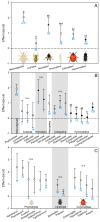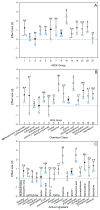Meta-Analysis of Herbicide Non-Target Effects on Pest Natural Enemies
- PMID: 37887799
- PMCID: PMC10607068
- DOI: 10.3390/insects14100787
Meta-Analysis of Herbicide Non-Target Effects on Pest Natural Enemies
Abstract
A critical component of integrated pest management is minimizing disruption of biological control by reducing the use of pesticides with significant non-target effects on natural enemies. Insecticide non-target effects testing for natural enemies has become increasingly common, but research examining the non-target effects of herbicides on natural enemies is scarce, and recommendations regarding herbicide selectivity are non-existent. We used meta-analysis to summarize laboratory bioassays testing non-target effects of herbicides on arthropod natural enemies and identify patterns in taxon susceptibility and active ingredient toxicity. Data were extracted from 78 papers representing 801 total observations. Herbicides increased natural enemy mortality and decreased longevity, reproduction, and predation. Mesostigmatan mites and hemipterans were the most sensitive to herbicides, and spiders, neuropterans, and hymenopterans were the least sensitive. Mortality was higher in juvenile predators versus parasitoids but did not differ between adults; parasitoid juveniles are likely better protected within the host. In terms of acute mortality, metribuzin, glufosinate, and oxyfluorfen were the most harmful herbicides. Only nicosulfuron, rimsulfuron, pendimethalin, phenmedipham, atrazine, and urea did not increase natural enemy mortality. The large effect size of glufosinate is particularly concerning, as it is the most likely replacement herbicide for glyphosate in many crops. Many active ingredients remain under-studied. Our analysis indicates that herbicides have a strong potential to disrupt biological control in cropping systems.
Keywords: beneficial insects; biological control; glyphosate; herbicide; meta-analysis; natural enemy; parasitoid; pesticide non-target effect; predator.
Conflict of interest statement
The authors declare no conflict of interest.
Figures




References
-
- Theiling K.M., Croft B.A. Pesticide side-effects on arthropod natural enemies: A database summary. Agric. Ecosyst. Environ. 1988;21:191–218. doi: 10.1016/0167-8809(88)90088-6. - DOI
-
- Croft B.A. Arthropod Biological Control Agents and Pesticides. John Wiley & Sons, Inc.; New York, NY, USA: 1990. Natural enemies and pesticides: An overview; pp. 3–15.
-
- Pimentel D. Ecological Effects of Pesticides on Non-Target Species. Executive Office of the President, Office of Science and Technology; Washington, DC, USA: 1971.
-
- Brittain C., Potts S.G. The potential impacts of insecticides on the life-history traits of bees and the consequences for pollination. Basic Appl. Ecol. 2011;12:321–331. doi: 10.1016/j.baae.2010.12.004. - DOI
Publication types
LinkOut - more resources
Full Text Sources

